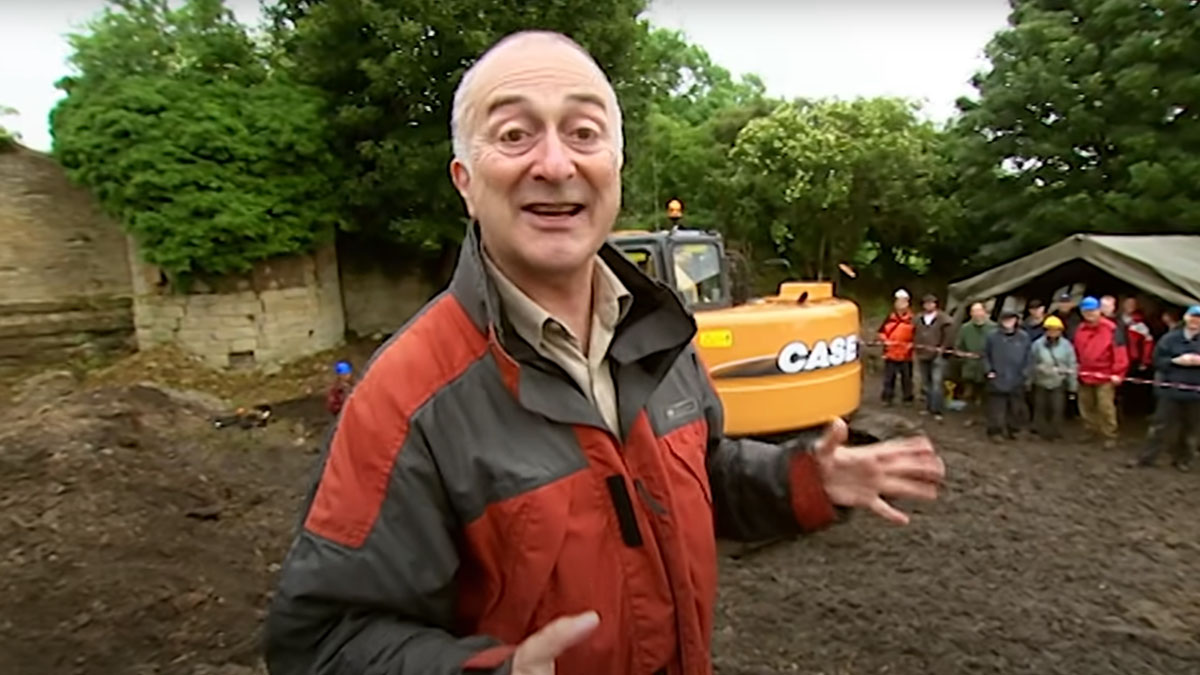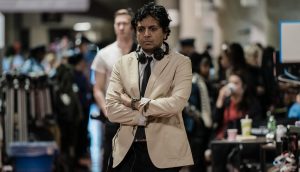
Starting in 1994, Channel 4’s exemplary reality TV series Time Team captured the imaginations of Saturday teatime audiences, coaxing them into the rich and fascinating landscape of the UK’s distant past with the promise of treasure troves of knowledge – and sometimes just plain old treasure – lying just beneath our feet.
Esoteric archaeological terms like ‘geophysics’ and ‘dendrochronology’ quickly entered the common language, as a nation’s eyes were opened to stories that had lain buried sometimes for centuries, sometimes for millennia. Time Team’s brief was to place the viewer side-by-side with the archaeologists in the trenches as they worked, seeing what they saw, sharing in their discoveries, and feeling what they felt. There were no gimmicks save the central one – the team had only three days in which to survey and investigate a site – which was necessary to prevent episodes lasting over six weeks, and the show’s editors having a mental breakdown.
It’s estimated that the show pumped somewhere in the region of £4m into archaeology throughout its original run – research, site surveillance, post-excavation services and reports – making it, to date, the single largest source of private funds for this branch of history and science in Britain. Not to mention the number of viewers it inspired to pick up a trowel themselves.
The real engine of the show though, was the earnestness, dedication, commitment, passion, humour and excitement of the team itself – ever-changing, but always with Sir Tony Robinson at its helm. Join us as we look back at six digs that encapsulate the range of everything that made Time Team so special.
Dripping with Gold
Gold in the Moat (Codnor Castle) S15E01
Metal detectorists’ zeal and enthusiasm can sometimes secure them a place on an official dig, but it’s not often they get to be the ones hogging the historical glory.
On a Time Team dig in Derbyshire in 2008, one plucky truffle-snuffler discovered something amazing in the moat of Codnor Castle: a gold noble coin carrying the face of Henry V, Medieval England’s pre-eminent warrior-king. As the detectorist handed the coin to Tony Robinson, his hand was visibly shaking. He must have felt like an armchair detective who’d just solved the Ripper murders.
It’s not often the ancient past can produce physiological tremors in its far-off descendants. The sight left viewers in no doubt they were witnessing a rare and significant find, and not just some rusty pound-cake tin someone had inexplicably buried in the 1960s.
Years later, Tony Robinson re-counted an augmented version of the tale, this one with an emphasis on bodily fluids. Apparently, as the trembling detectorist transferred the gold noble from his hand to Tony’s, snot from his nose joined forces with the lashing rain, and the unpleasant result landed, along with the coin, right on the palm of the presenter’s hand. Tony had to spend the next thirty or so seconds doubling down on how excited he was, rather than drawing attention to the mucous by exclaiming, ‘Aargh, it’s bogies’, before accidentally flicking the coin back into the moat.
The coin was printed in the Tower of London sometime between 1415 and 1420 (that’s AD, not PM). It’s not known if any attempts were ever made to carbon date the metal detectorist’s snot.
Bard to the Bone
Searching for Shakepeare’s House (Stratford-upon-Avon) Special, 2012
Time Team had little interest in projecting our modern obsession with celebrity onto the canvas of the past, preferring instead to bring the lives and habits of ordinary men and women into sharper focus. But there were exceptions, most notably their quest to investigate the man who put more high-school-age children to sleep at their desks than any other in history: William Shakespeare.
The grounds of Shakespeare’s Stratford-upon-Avon home, New House, demolished in 1702, were excavated in the 19th century. The archaeologists found nothing of significance, but the Time Team possessed a piece of knowledge that their Victorian antecedents had not: that they’d been digging in the wrong place. In the intervening years, a document with a floor plan of New House had been discovered, and it had completely changed the archaeological goalposts.
Not much evidence of Shakespeare’s civic and familial spheres exists beyond a handful of official documents, so our portrait of Shakespeare the man has always been a blurry one. Just how did this jobbing playwright from a failing family glove business (insert your own Glove’s Labour’s Lost joke here) manage to live and maintain a life of prestige and luxury – with a score of servants at his beck and call – so early in his life and career?
Beyond the obvious answer of ‘inheritance’, the excavations of New House built up a picture of Shakespeare as an ale-brewing, aspirational wheeler-dealer, with a wife half-addicted to renovations – a Tudor-born Marlene and Boycie. Shocking and breath-taking moments were thin on the ground in this special, but there was nevertheless real joy in seeing Shakespeare’s family home finally and firmly delineated. We even got to see the likely location of the room in which that rock star of the Elizabethan Age probably boiled his pants (insert your own Pant-ony and Cleopatra joke here). And it doesn’t get much more celebrity and salacious than that.
Villa Thrilla
Turkdean (Gloucestershire), S05E04
Tony Robinson has been always drawn to history. You could say it’s been a defining thread of his career: from his role as Baldrick, the disgustingly adorable peasant nincompoop in the BBC comedy Blackadder, to his beloved children’s comedy series Maid Marian and Her Merry Men, to the many history books he’s authored. Time Team itself might not have existed – at least as we know it – if not for Tony Robinson having a chance meeting of minds with future Time Team stalwart Mick Aston while on an archaeological dig in Santorini.
Robinson is always at pains to demarcate himself from the professionals, to emphasise his role as a facilitator and front-man. His enthusiasm has always been married to an endearing humility, which keeps in check any inclination to steal the academic limelight. When he was handed a trowel during a Time Team dig in Gloucestershire – the goal of which was to uncover evidence of a Roman settlement – he said his first thought was: “I’m not an archaeologist, I’m just someone people think is an archaeologist.” His second thought was probably: “I might be about to desecrate history.” Moments later, he realised he’d uncovered the mosaic tile floor of a lost Roman villa, unseen by human eyes for a millennium or more. It was a moment he would later described as one of the greatest of his life.
I Build on Your Grave
Bodies in the Shed (Glendon) S13E01
It says something about the reserved nature of your average English gentleman that he could discover, while undertaking building work on his property, 111 dead bodies, and go on to discuss it on television with the sort of dry matter-of-factness usually reserved for reading out the shipping forecast. As Tony Robinson prowled the area, striding over bones, half-dug pits, and coffin-shaped chalk-outlines, the land-owner, Martin Hipwell, could barely restrain his total lack of excitement.
But then, these were the bodies of medieval peasants many hundreds of years dead, so we can forgive the absence of shock. Robinson and the team quickly leapt into action as detectives with an unusually long incident response time. They wanted to discover who these people were, how and where they lived, and the precise location of the church that presided over their graves.
At one point in the episode, the team learns that there may be pictorial proof of the church – long since demolished – in the archives of the National Library in London. Unfortunately, the document is too valuable to leave the library, and photography isn’t allowed, so one of the team, Victor, is dispatched to London to sketch the findings, and hurry back to Northamptonshire with the results. It’s testament to the show that this race against time on a medieval cold case is imbued with the sort of cliff-hangery urgency most often found in Hollywood movies. The disappointment that Victor returns with – an admittedly beautiful sketch that appears to show not the spire of a church, but a lofty garden feature – is palpable.
The team finds no trace of the town the peasants would have called home, leading to much head-scratching, until they’re forced to conclude that the evidence probably lies beneath the neighbouring Glendon Hall – and no one was going to be demolishing and excavating that any time soon. It seems some bodies, and bodies of work, are destined to remain buried. We can only wonder if some distant antecedents of the Time Team will return to investigate the site with nuclear-powered atomising drills at some point in the late 27th Century.
We’ll Meet Again
One of the First Spitfires Lost in France, Wierre Effroy, S07E03
Most of Time Team’s forays into history concerned the distant past, but a special episode to recover the downed and buried Spitfire of English pilot Paul Klipsch, who perished in combat on the 23rd of May 1940, from a crash site in Northern France, was close enough to home – chronologically speaking – to pack a mighty emotional punch.
Paul Klipsch’s step-brother Eric accompanied the Time Team and a coterie of aircrash investigators and Spitfire historians to Wierre Effroy. It was the first time Eric had set foot in the country since D-Day. As the team interviewed local eyewitnesses, and began digging in earnest, a picture emerged of a plucky young man thrust into peril on his first major combat mission. Eric remembered that Paul had cheekily swooped down over the family home just before his flight to France, a happy memory somewhat sullied by the events that followed. Namely that Paul’s squadron of 12, trained mainly to bring down bombers, became embroiled in a dog-fight against 60 German fighter planes. Paul, and three other pilots, lost their lives. Eric lost his brother.
Towards the end of the programme, with the remains of Paul’s Spitfire finally untombed, Eric was presented with a part of the jacket Paul had been wearing on his flight, along with a picture of him, all smiles and excitement, as he prepared to climb into the Spitfire from which he would never climb out. Eric died shortly after the show was filmed, but watching the reverence with which he handled that fragment of his long-lost brother’s last day, it was impossible not to conclude that this was the proper – and final – emotional farewell the two men had never been afforded in life. A heart-breaking and undeniably heart-warming moment.
Wire Fraud
The Celtic Spring (Llygadwy, Powys) S08E03
When Welsh land-owner Ben Samuels and his son-in-law Creighton Ridings invited the team to excavate a spring and surrounding areas on their land in Llygadwy, Wales, they claimed it was a treasure trove of Roman artefacts. And so it proved. But as the finds piled up, so too did the team’s suspicions. They worked initially on the assumption that the spring had been a site of spiritual pilgrimage to which generations of Romans had come to make offerings. But there were major inconsistences with the chronology of the deposits and the type of artefact (likely era/time of manufacture based on appearance and materials used). An ‘archaeological theme park‘, was a phrase one team member used to describe the site.
The question mark hanging over the site quickly became an exclamation point when subtlety gave way to ‘Carry on Antiquing’. Some Roman coins retrieved from the spring were found glued together. A Victorian marmalade pot was discovered among the antiquities. A set of supposedly ancient standing stones on the property were incredibly easy to rock (excuse the pun), something that shouldn’t have been possible if they had been embedded in the earth for as long as the landowner claimed. The piece de resistance was an Iron Age sword found resting deep in the soil above a length of barbed wire. The stratigraphic analysis speaks for itself – namely that the balance of probabilities is set against the barbed wire having been manufactured in the Stone or Bronze Ages – but, just to be sure, the team was able to date the style and composition of the barbed wire to 1980. While there’s no suggestion that the landowners indulged in deliberately unsavoury practises, people have been known to collect and deposit genuine artefacts in locations they don’t belong in a bid to increase their value at auction. All Creighton could say when confronted with these howling inconsistencies were things like: “Could the barbed wire have worked its way down the soil and slid underneath the Iron Age sword?”
“No,” said Tony, conjuring all his powers of civility.
While the dig failed to uncover anything of useful historical value, it was far from a wasted trip. The dig brought into sharp focus the solid science and dogged detective work that forms the bedrock of the team’s methods: a system that prioritises – every single time – truth and knowledge over fame and riches.
While Time Team is no longer broadcast on television, its work and stories continue on YouTube.
The post When Time Team Dug Up a Faked Site & Other Unforgettable Digs appeared first on Den of Geek.






